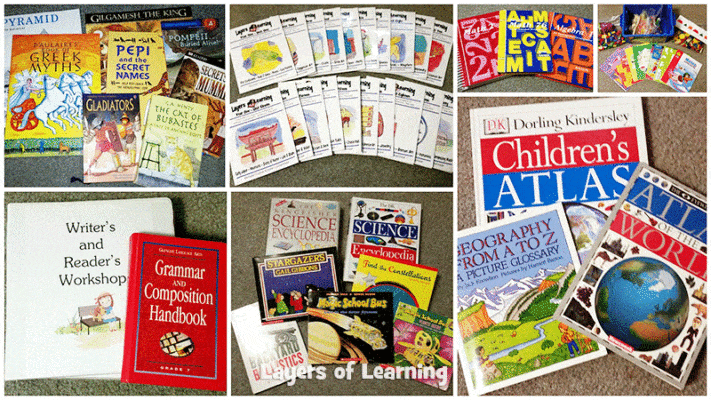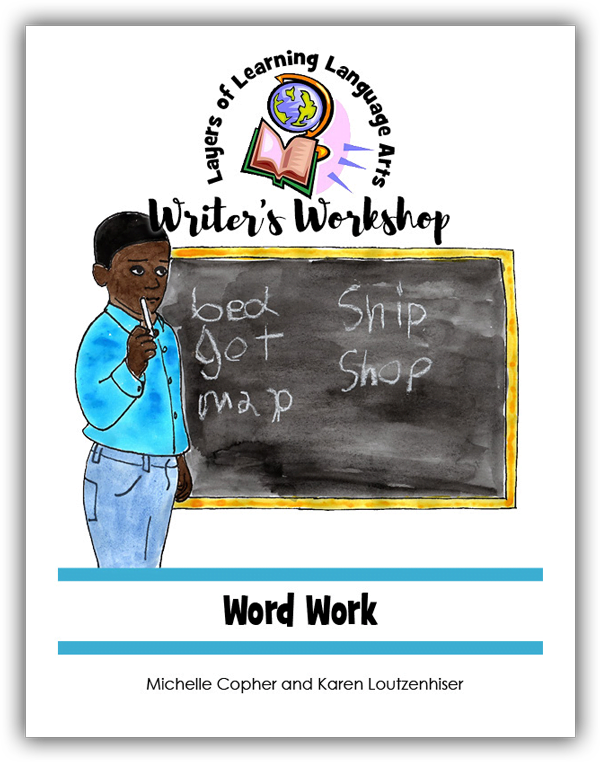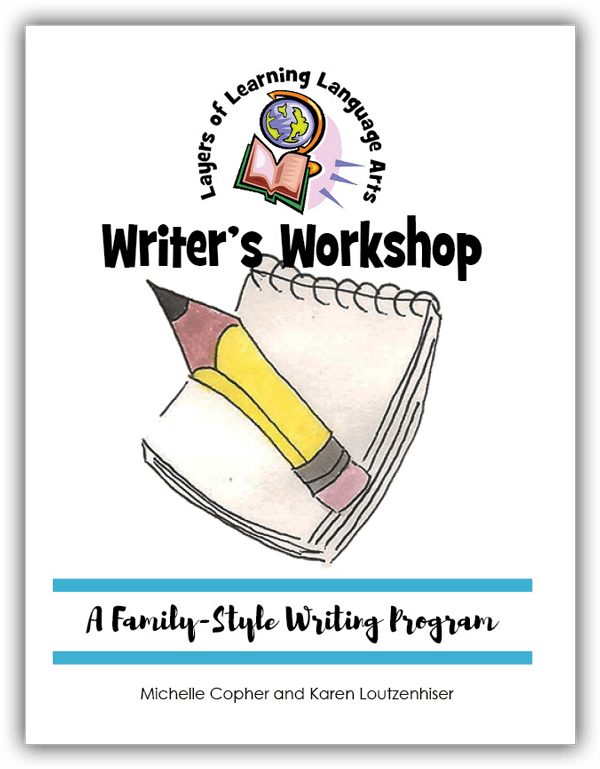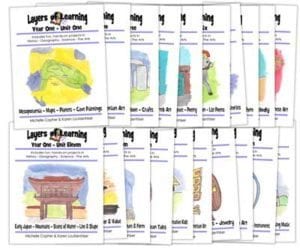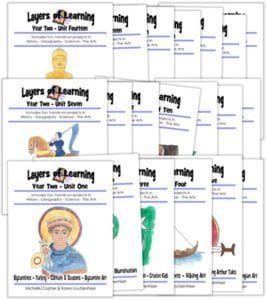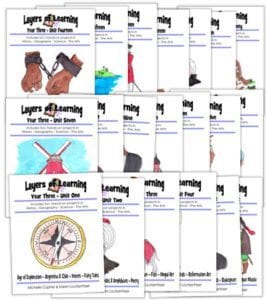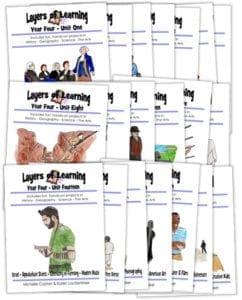Buying homeschool curriculum and supplies is a big commitment. It’s hard to know where to begin. Your choices will depend on your homeschool style and your budget, so please keep those in mind with every single purchase. So let’s walk through the process of planning and purchasing curriculum for your homeschool.
- Get basic supplies.
- Buy curriculum for the 3R’s.
- Buy curriculum for the essentials.
- Buy curriculum for your electives.
Our goal is to help you run the very best homeschool you can. That means spending the bulk of your budget and time on the most important things. If you can read well, you can learn anything. If you can write, at least decently, you can succeed at any vocation and communicate with others effectively. If you can do arithmetic (up to algebra) you can handle any math that might come at you and reason logically.
History, geography, science, arts, foreign languages, logic, and so on are not unimportant, but they should be your second focus, not your first.
The things we recommend below are really for real our favorites. We’ve used many, many things, but these are the staples we’ve stuck with. When you click on the images or links they take you to Amazon where you can buy the books. These are affiliate links, which means we get a small commission for referring you. This doesn’t change your price. It’s a nice way for you to say thanks for all the free content and help we provide here at Layers of Learning.
1. Get Basic Supplies
All you really need to get started with homeschooling is a little information, a notebook or paper, pencils, and a library card. You can make up your own lesson plans and teach your child without curriculum if you like.
Click through the tabs below to see which things we have felt are essential or very useful in our homeschools.
- Information about teaching
- School supplies
- Office supplies
Teaching Basics
As a homechooler, you are a teacher. And while we agree that homeschool parents can do as well or even better than public schools at teaching, that doesn’t mean it happens automatically. The better educated you are about how to teach, the more effective you will be. You can’t ever get back the years you waste or fail to teach your kids properly because of your own ignorance.
These books are some of our favorites about homeschooling, teaching methods, and learning methods.
How to Teach
The Well Trained Mind teaches specifically about how to teach classical style homechooling. And even though neither Michelle nor I are strictly classical in style it influenced us immensely. We re-read it every now and then to keep, or get, on track. It’s definitely a common sense and practical how-to book on teaching all the most important subjects.
A Thomas Jefferson Education promotes the idea of an individualized leadership education. If you want to homeschool in a style different than the traditional school approach, but aren’t sure how, this book might interest you.
How To Talk So Kids Can Learn teaches you real techniques for communicating with kids in a way that helps them learn. It uses little scenarios and shows how teachers and parents can really hear, understand, and speak in a way that reaches kids. Some of the scenarios are classroom based, but it focuses on one-on-one communication and is really applicable to parents, especially homeschool parents.
Teaching Writing
For many parents and students writing is the toughest subject to teach and learn. Read Any Child Can Write early and often in your homeschooling career to stay on track with creating a writing rich home that encourages kids naturally to want to write.
Teaching Reading
Kids who are read to by their parents are light years ahead of those who are not. The Read Aloud Handbook explains why and how and when to read aloud to your child.
Honey For A Child’s Heart is a list of the best books for children with descriptions. The first part of the book explains why reading and being a reading example are so important. Use this to help you find books at your library to fill your home with literature.
Teaching Math
Mathematical Mindsets by Jo Boaler explains how to talk so your students get a growth mindset about math, an attitude that accepts that you can learn hard things and get smarter over time. The book also specifically addresses how to teach math so it is a vibrant living, engaging subject and not a dead subject with nothing but rules to follow and procedures to memorize. You can use her methods with any math curriculum.
Teaching with Love
When you homeschool, you are together 24-7 or close to it. Relationships between family members in most homeschool families are much closer than relationships in non-homeschool families. You can be an even more effective parent if you set out deliberately to nurture your children. We love The 5 Love Languages of Children. It’s eye-opening and the things taught are practical and life-changing for you and your kids.
School SuppliesSchool Supplies
The list of school supplies that would be nice to have is endless and no doubt you will amass many through the years ahead. But here, I’m going to keep it short and stick with the things we have actually used most in our own homeschools, the things we wouldn’t like to school without. You will probably think this list is very obvious and it is, but still, it’s nice to kind of go through and make a checklist of what you’ve got and what you’ll need.
I purchase most of our school supplies in August when they are on sale at the local stores, but you can often get good deals online as well.
We use lapboards a lot, especially when our kids are young. You can use them during a spelling lesson, for math practice, for grammar, and so on. They’re very useful as a portable “blackboard” for the teacher as well, say if you want the kids to copy a sentence or definition. Kids find them fun and it saves on paper.
Michelle swears by using wet-erase markers instead of dry erase. If you leave the dry erase marker on a board, say overnight because you forgot to clean it, it will be stained forever. And kids can so easily accidentally erase bits with their sleeves before they mean to. This does not happen with wet-erase. Wet erase markers also have a finer point and more vivid colors.
We use binders to organize and store all the work the kids do. They have a binder for Writer’s Workshop, with dividers. A binder for Layers of Learning subjects, with dividers. And sometimes we have another subject they’re working on that needs a binder, so I usually buy 3 binders per child per year. We use dividers for spelling, writing, and grammar. Then dividers for history, geography, science, and arts. So about one pack of dividers per child per year.
Paper, obviously. Story paper is great for young kids. They can draw a picture at the top of the page and then write about what they drew on the lines beneath. We use this method when learning about science and history topics especially.
Up to 3rd grade my kids use the primary journals for writing about their day or doing creative writing journaling projects. Little kids love to draw pictures and since this helps with fine motor skills and writing, I encourage it. The composition books for the older kids are used for all sorts of subjects, most notably we keep our writer’s notebooks here. These are places we jot down our writing inspiration, do writing warm ups and so on. Finished work gets typed or written nicely and put in the binder instead. These books are by far the cheapest to stock up in August during the back to school sales. I usually buy about 6 per child per year, but Michelle only buys about 2 per child per year, one for Layers of Learning subjects and one for English.
This is a notebook filled with graph paper instead of normal ruled lines. I really like to use this for math, especially once kids hit about 6th grade because they start to do quite a bit of graphing and geometry and it’s useful to have graph paper. But it’s nice even at the younger grades because it helps kids line up their columns of numbers and stay neater. So each of my kids, Saxon 5/4 level and up, gets one of these each year. If you use both sides of the sheet you’ll just about fill it up in one year.
Pens and pencils. You will need more than you realize. Again, I stock up on these in August at back-to-school sale time. I really like using fat pencils for kids up through 1st grade. It’s just easier for them to grip. I keep red pens on hand for correcting papers and tests.
Crayons for younger kids and colored pencils for 5th grade an up are important for completing all sorts of printables and projects. Get a set that has at least 24 different colors.
Long ago I decided I hated searching the house for scissors, so I bought a dozen pairs. We do have a spot for them in the house, but you know, kids. They don’t always stay where they ought to. These are inexpensive enough to stock up on and they are good quality.
You also need glue for all sorts of projects. Glue sticks are best for printables and paper and school glue is best for most craft projects.
Office SuppliesOffice Supplies
And of course, all the basic office supplies. You probably have most of this already on hand.
- Hole punchers
- Stapler
- Pencil sharpener
- Scissors
- Printer
Early in my homeschooling I realized that it’s worth it to buy quality instead of cheap whenever possible.
You will need a good printer as a homeschooler. If you don’t have a printer or don’t like your current one we recommend an Epson Supertank printer. It uses tanks instead of cartridges for ink which cuts down dramatically on printing costs. The printer will pay for itself in six months if you print almost daily as I do.
2. Buy Curriculum For The 3 R’s
Of course it is much easier to purchase curriculum, especially in the areas you don’t feel so confident.
So the next step is to purchase curriculum in the most essential subjects:
- Math
- Reading
- Writing
Back in the day these were called the 3 R’s. They are still the most important subjects. If you did nothing but teach your kids well in these areas you would be a success. So when you’re starting out homeschooling and the budget is tight, this is where you put your money first. When life gets stressful or you’re feeling burned out, it is into these subjects that your put your remaining effort.
When both Michelle and I started we had our Saxon math, a notebook for journaling, and some books from the library. That’s it. Really.
Click through the tabs below to see our favorite curriculum picks for these subjects. You can click on the pictures or links to add them right into your Amazon shopping cart.
Reading Writing Arithmetic ReadingReading
A library card is all you really need to teach reading to your child from kindergarten to graduation. There are a few books below that will help a great deal, especially when you’re teaching your child to read for the first time.
Learning to Read
We recommend Phonics Pathways because it uses phonics, not whole language, instruction, is easy for the parent to use, is organized into short lessons that you can move through at your own pace, and it has excellent reviews from lots of parents who have said it just plain works. As an added bonus it is friendly to older students or even adults who have not learned to read yet. Reading Pathways is the follow up book that will launch your child from sounds and blends into actually reading.
We’ve also both used How To Teach Your Child To Read in 100 Easy Lessons. Our biggest complaint about this book is that it’s not visually friendly, but the DISTAR reading method really is helpful. If reading doesn’t come naturally to your kid, this step-by-step method will probably help.
If you want extra practice with phonics we’re fans of the Explode the Code series and have used it with all of our kids.
By the time your child has finished learning the first few sounds on the letters she can start reading with the Bob books. I used them with all of my brand new readers.
Literature
Honey for a Child’s Heart is a book of book recommendations by level and interests. We highly recommend this as a way to find worthwhile books for your kids. I was trained in early elementary education and have kept my own annotated list of books since my college days, so I don’t have or need this book. But Michelle has referenced this book for years. The parent uses this and then visits the library to gather the specific books for their child to read or for the parent to read-aloud to the child.
As far as learning literature forms and discussing great literature, the best method is to choose a book you want to read and discuss and look up the free Sparknotes literature guide for that book online. Either the parent or the student can use Sparknotes to get information about themes, literary devices, characters, summaries, and so on. Then the parent leads a discussion, assigns a paper, etc.
There are also dozens of different publishers who sell literature guides. Feel free to investigate any of these as you like. We’ve never used any of them personally in our homeschools.
Honestly, in our homeschools, we normally just let our kids read, read, and read. Only occasionally do we discuss books in a formal way or write papers about them. And then the purpose is usually college prep.
WritingWriting
Writing includes handwriting, spelling, grammar, and creative and expository writing. All you need to teach writing is a pencil and some paper. But, if you’d like a little more guidance or just convenience then take a look at what I use in my homeschool.
Handwriting
To learn handwriting without a curriculum, write letters, words, and sentences in yellow pen and have your child trace your writing. Later you can write in pen on a separate piece of paper and they can copy instead of trace. This is tedious though. I recommend these inexpensive workbooks instead.
Handwriting Printing includes lots of practice and does, not only individual letters, but words and sentences as well. This book is also very affordable. Start using this in 1st grade for most kids. Follow up with Handwriting Cursive starting in about 3rd grade, depending on where your child is at reading. A struggling child can delay for a year or two or an advanced child can move ahead.
Draw Write Now is an excellent series that can fill the gap between your child learning to form the letters and when they are ready to start cursive. Michelle’s kids have especially loved these books. They make writing interesting for kids, even boys. If you don’t want to spend extra money on these you can also just have your child write journal or narration pages, copying your handwriting.
Wacky Sentences makes cursive practice less boring. Use this after your child has completed the cursive handwriting book above as extra practice. Again, if you don’t want to spend the money, you can also have your child copy your cursive handwriting sentences when they do narration or journal pages.
Cursive Writing Practice is more serious. Your kids are writing famous quotes from famous people. We like this too, especially if your 5th or 6th grader still needs cursive practice.
Spelling
The best way to teach spelling is to find misspellings in your child’s writing and practice those words, week by week. Add to it by doing holiday words, number words, days of the week, words that go with your other subjects, and so on.
To make spelling one of the fun subjects of the day and to help the words stick in your child’s mind use the Word Work program, which is for all ages of spellers.
Grammar & Writing
Grammar is best taught little by little, piece by piece, and through a child’s writing. Writing is best taught incrementally and from the lens of self-expression as well.
We recommend a family-style Writer’s Workshop for your family. It will turn kids into writers, not worksheet filler outers. It also includes mini lessons in the sidebars that cover writing skills and grammar in tiny bite-size pieces – no worksheets.
Arithmetic
Arithmetic
Arithmetic includes the four operations, fractions, decimals, percents, and so on. Basically it is everything you learn before algebra and geometry. Then the student uses those skills to study algebra, trigonometry, geometry, and calculus.
Basic Operations
Not many parents feel confident enough to teach math without a curriculum, but if that’s you, all you really need is a notebook and a pencil. If you’re really up against a rock and a hard place and can’t afford the expensive math curriculum then we recommend Khan Academy. We don’t use them for our basic curriculum, but we use their videos all the time when teaching new concepts to our kids. And you can use them for a basic curriculum.
Saxon Math is by far our favorite math curriculum. It teaches students one little bite of information each day and the student practices that bite, then practices all the previous bites they’ve learned. This is the spiral approach to math, as opposed to the mastery approach where kids practice a single skill until mastery and then drop it to move on to another skill.
The manipulative kit is an absolute necessity for the first three levels of the books. We very strongly recommend that all beginning math students use manipulatives no matter which math curriculum you end up using.
If you are a parent who never “got” math during school, then this is the perfect curriculum for you too. You will learn it right along with your child. While teaching this curriculum we, as adults, had dozens of “ah-ha!” moments where we finally got the concepts we ought to have learned in elementary school. If your kids don’t have a strong arithmetic foundation they will not succeed at algebra and beyond. This series gives them that foundation.
Use the books in this sequence:
- Math 1
- Math 2
- Math 3
- Math 5/4
- Math 6/5
- Math 7/6
- Math 8/7 (This is extra practice and preparation for algebra, so if you have a talented math student he or she can skip this book. However, most students probably should not skip.)
- Algebra 1/2
- Algebra 1
- Algebra 2
- Advanced Math
- Calculus
Higher Level Mathematics
To do well on the S.A.T.s or other college entrance exams, your student needs to complete through Algebra 2. If you are interested in math or science fields or want to get into a competitive college, then complete at least through Advanced Math.
Students who really hate math can stop after Algebra 1, though they will not be as ready for college, but many colleges now offer lower level math classes like basic algebra to students who need them. Still, we strongly recommend you get through Algebra 2 if at all possible.
Remedial/Extra Practice
If you have a student who isn’t “getting” Saxon, needs review or extra practice, or has gotten behind, we can’t recommend this series highly enough. It cuts right to the chase and teaches all the essentials for arithmetic, algebra, and geometry. The lessons each take just 20 minutes a day, so it’s also great for summer or for parents to do with their kids alongside their normal curriculum.
Use the books in this order:
- Mastering Essential Math Skills Book 1
- Mastering Essential Math Skills Book 2
- Pre-Algebra Concepts
- No-Nonsense Algebra
Or, if your child is struggling with a specific topic (like fractions) you can choose just that book or that book in addition to the main sequence. The publisher’s website also has videos that go with the books for sale.
Math Tools
These are tools you need to have on hand as you advance in mathematics. Because kids tend to be mentally lazy if you allow them, we don’t like calculators before about 8th grade. Also, there is a portion of the SAT that does not allow calculators. Students don’t really need them until they begin logarithmic functions, which is in Algebra 2.
Make sure you do actually use a scientific calculator. You can tell because it has the sin, cos, and tan keys. Kids usually prefer the Texas Instruments brand because you can enter an equation in the exact order it is shown in your textbook, see the entire equation inside the display screen and edit it. Again, this can cause mental laziness. So if you want them to have to think about how the numbers are actually being calculated, and in what order, and to use care, buy them a Casio instead.
3. Buy curriculum for the essential subjects
The essential subjects are those that should be taught, if not constantly, then at least frequently throughout the school years. In my homeschool each of these subjects is taught at least once a week. They are:
- History – the story of everything that came before. This subject helps us understand where we came from, the debt we owe the past, and warns us against future follies.
- Geography – the study of the world as it is now. This subject is so much more than maps. It’s about the condition of humanity in the present day. You study cultures, languages, locations, landscapes, and governments that shape the world you live in.
- Science – the study of the natural world. A decent science education, even if science isn’t your thing, will make you proof against charlatans. Even more importantly, science teaches logical thought patterns, observation, curiosity, and objectivity.
- The Arts – the beautiful things. Arts includes literature, plays, poetry, paintings, sculpture, photography, design, film, and music. These are the results of society’s hard work, the reward, if you will. Until you study this area, you can’t possibly appreciate it or gain much value from it.
We recommend you use the Layers of Learning curriculum for your history, geography, science, and arts. Here’s why.
- We’re extremely thorough. We cover more cultures and times, places, and topics than any other curriculum we’ve seen.
- It fits every learning style and every teaching style. We include worksheets, writing projects, books, videos, hands on activities, games, and more. But it’s all adaptable to your preferences and needs.
- It’s inexpensive. The program covers all the four of the essential subjects (history, geography, science, arts), can be used for all of your kids at once, and for all the years of their education, making it an excellent value. You need buy each year only once and that’s your kids’ whole education in these four essential subjects clear up to graduation.
Below we have our year packages which sell at a discount off the regular price. But you can also buy one unit at a time by visiting our catalog.
4. Choosing Elective Curriculum
So now you should have an idea of what you want to teach this year in your homeschool. You may also want to add an elective or two each year or each semester. Here are some ideas:
- Religion/character building – this can also be done in a separate family tine or as part of the morning meeting.
- Foreign Language – Modern languages like Spanish, German, French, Japanese, or Arabic can be taught with Duolingo, a free online language course. If you want to teach Latin we recommend Getting Started With Latin by William E. Linney, a truly beginner-friendly course.
- Music – If possible every child should take at least two years of music lessons. The piano is a popular starter instrument. If you can’t afford private music lessons, see if your child can participate in band or orchestra at a nearby school.
- Life Skills – lessons like cooking, auto maintenance, finances, or crochet are valuable for children to learn. Most life skills can be learned in the course or normal family life if you have your children by your side as you go about your daily duties. But sometimes a dedicated course is nice too.
Ready To Plan?
Once you’ve chosen your curriculum, you’re ready to plan out your whole homeschool year.
Step 4: How Do I Plan My Homeschool Year?Get a Free Unit
Choose between the first unit in each Layers of Learning subject to try for free when you sign up for the newsletter.
We never spam and you can cancel your subscription at any time.


